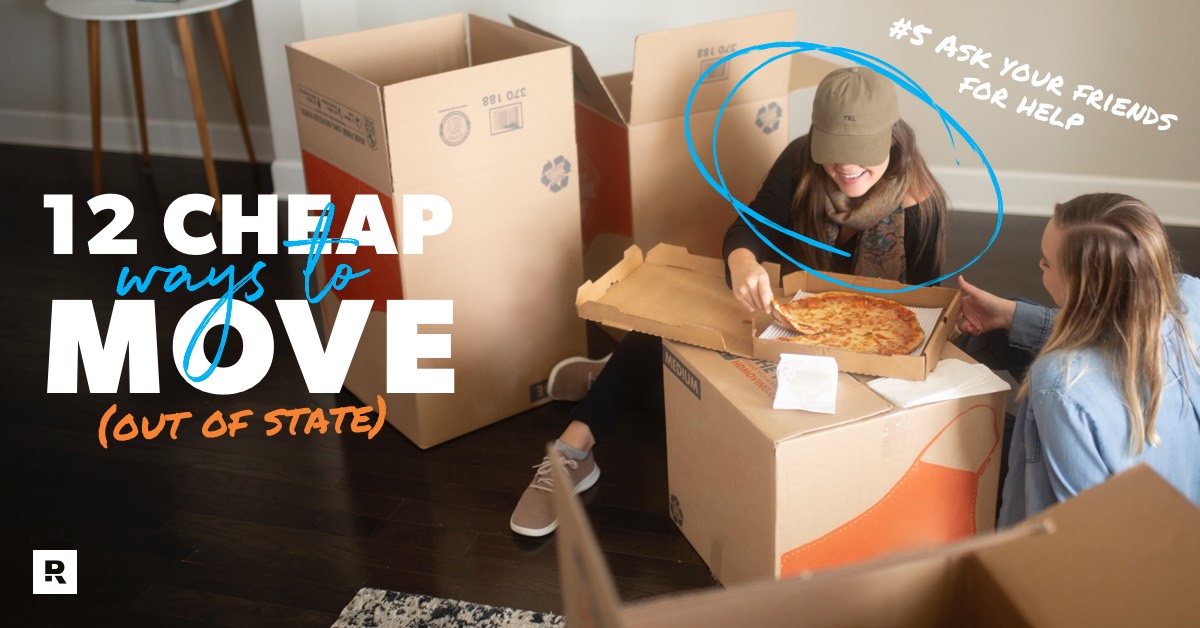
So you’re looking for ways to save money as you embark on a journey to a new state. You came to the right place! We believe budgeting is one of the best ways to achieve your goals. And with out-of-state moving costs averaging $2,700–7,000—good grief!—you’re smart to be looking for the cheapest way to move out of state.1
Sure, it’d be pretty easy to save money if everything you own could fit into the trunk of your car. But if you live in a house packed to the rafters with stuff, there are still ways to keep your moving costs low—and we’ll show you how.
Let’s get started!
12 Cheap Ways to Move Out of State
Amp up the excitement around your new adventure by using these tips to save when you move out of state.
1. Pile Up Cash for Moving Expenses
First, the cheapest way to move out of state is to pay for your move in cash. That way you’re not wasting money on interest. Swiping a credit card to cover unexpected moving costs will only load you up with debt—and debt is dumb! Trust us, getting stuck with credit card payments after you’ve moved is no way to enjoy a fresh start.
So, plan every step of your move and create a moving budget. You can reach your goal faster by finding ways to save money—like temporarily cutting things you don’t need from your monthly expenses.
2. Declutter So There’s Less to Move
Okay, another way to lower your moving expenses is to get rid of junk. Some things lurking in your house just need to be dumped in the trash—like VHS tapes, broken furniture and gadgets with missing pieces. Other items like the treadmill, fishing boat and foosball table might be things you want to bring. But keep in mind, they’ll probably bump up your moving costs. Here’s a pro tip: Sell large or heavy items like those and use the money you pocket to replace them after your move. Bingo!
3. Pack With Free Supplies
This one’s a no-brainer. You can find free packing boxes all over the place. Hit up your local grocery store, mall and movie theater. They’re bound to have plenty of boxes that get recycled every night. Ask if you can take those boxes off their hands and—voila!—you found yourself a gold mine of free packing supplies.
Speaking of packing supplies, sure, everyone loves the addicting satisfaction you get from popping bubble wrap. But when packing fragile stuff, you can probably get away with crumpled-up newspapers, towels, pillows and blankets. Hey, those towels and pillows have to move too! And you don’t need to buy a fancy label maker either—a black permanent marker will work just fine.
4. Negotiate for a Relocation Package
This option could possibly be your cheapest way to move out of state—if you’re lucky, it might even be completely free for you! A relocation package is when your employer offers to cover all or some of your moving expenses. While this benefit isn’t a given, many employers do it as a way to recruit the best talent. So if you’re moving for work, be sure to ask if a relocation package is available. Here are some examples of what one might cover:
- Trips to go house hunting in your new location
- Certain costs associated with selling and buying homes
- Shipping costs to move all your stuff (including packing and unpacking)
- Travel expenses for your final move
- Temporary housing
Generally, a relocation package comes in the form of a reimbursement for all your moving costs or a lump sum. If you’re not satisfied with what’s offered to you, you could try to negotiate a better relocation package. Do your own cost research and see if your employer would be willing to match it—no harm in asking.
5. Ask Your Friends for Help
That’s right. Bribe your friends to help you move and pay them with extra-large pizzas. Paying for a few pizzas to recruit free help is way cheaper than hiring professional movers. Plus, it’s a great way to squeeze in one last memory with your pals.
Most of your friends may only be able to help you pack and load. But your closest friends might even cross state boundaries to help you move a car or unpack! Just make sure you’d be willing to return the favor.
Your Guide to Making Smart Moves to a New City
Follow our simple, step-by-step plan for a smooth relocation process so you can settle into your new city with confidence.
6. Move During Winter or Weekdays
People who find cheap flights to Paris fly when others aren’t flying. It’s the same with moving. Plan your move during the off-season. Yup, that means scheduling your move around unpopular travel times—when kids are in school and the weather outside is frightful. And try to avoid moving on weekends and holiday breaks.
Sure, it might feel inconvenient moving during a dreary business day. But it could shave some serious dollar signs off your moving expenses since demand for equipment won’t be as high.
7. Use Public Transportation
So this option will probably only work if you’re a minimalist. Let’s say you live in a city and don’t own a car. Maybe you’re moving out of a small studio apartment. Remember, you can always sell your furniture and replace it later. Then declutter the rest of your items down to a few compact boxes. If you can do all that, your cheapest way to move out of state could be to use public transportation like a bus or train—costing just a few hundred bucks.
To make sure your stuff can fit on a bus or train, check the weight and dimensions of your items. Greyhound, for example, allows you to store 150 pounds of luggage under the bus.2 Meanwhile, Amtrak allows you to ship up to 500 pounds.3 Both services have shipping size limitations, so be sure to pack accordingly.
If your move requires you to travel to remote states like Hawaii or Alaska, you might have to look into freighting your items by air or water.
8. Haul a Cargo Trailer
Depending on how much stuff you have to move, you might be able to fit it all inside a cargo trailer—you know, those rectangular containers on wheels that hitch to the back of a vehicle with towing capacity. No. Not the ones with ponies in them. Unless, of course, you’re moving a pony.
If you already drive a pickup truck or can borrow one, this might be a good option that will only cost a few Benjamins.
9. Rent an Affordable Moving Truck
Alright, if you need to move a bunch of furniture and appliances, your cheapest option is probably to rent a moving truck. On average, renting a moving truck or van costs between $50 and $2,000.4 Prices go up based on truck size and travel distance—so moving out of state may be on the pricier side. But if you rent a moving truck with towing capacity, you can tow your car and move everything to your new state at once and save on gas and mileage.
Since you’ll be saving the cost of hiring professional movers with this option, just prepare yourself for some challenges—like loading and unloading your car for towing, backing up without a rearview mirror, and tight maneuvering in parking lots. It may take some getting used to, but if you’re up for the adventure, the experience will likely become a memory you’ll look back on and laugh about later.
10. Rent a Moving Container
You’ve probably heard of popular moving companies like U-Haul and PODS that let you rent storage units to use for your move. These are probably the most convenient options—but they can also be the most expensive.
On average, renting a shipping container for a long-distance move of more than 400 miles costs between $700 and $5,000.5 It might be a cheaper option than renting a moving truck or hiring movers, but not always. So, make sure you get price quotes to find the most reasonable option.
11. Hire Budget-Friendly Movers
While hiring movers is by no means the cheapest way to move, it might be your best bet if you can’t find friends or family to help you pack, load and unpack—or you don’t have any time to handle the moving process yourself.
Remember, the average price to hire movers for a long-distance move costs between $2,700 and $7,000.6 Shop around and ask for price quotes to find the most affordable (and legit) moving company.
12. Avoid Paying for Insurance You Don’t Need
No doubt you’ll be asked a bazillion times if you want insurance for your move. Whether it’s for insurance to protect you in the event of damage or theft to rental equipment or your possessions, you could be tossing a flurry of dollars out the window if you sign up for coverage you already have.
Check your home and auto insurance policies to see if you’re already covered during a move. If you are, you won’t have to pay for extra insurance from the moving company.
Ready to Save Money on Moving Costs?
If you want more ideas on how to make smart money decisions during your move, check out our free Relocation Guide. It walks you through every step you need to take for a smooth and confident transition to your new state—without busting your budget.
Next Steps
- Use our Relocation Guide to plan your moving budget.
- Save up so you can pay for your move in cash.
- Interview at least three real estate agents in your new state. For a quick and easy way to find agents in any state, use our RamseyTrusted program. We only recommend the highest-performing agents who value the Ramsey way of doing real estate.
Did you find this article helpful? Share it!

We Hear You!
We’re considering adding the ability to save articles to your Ramsey account.




